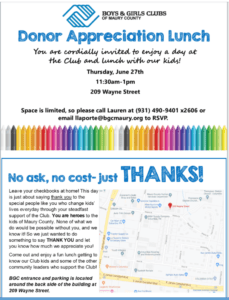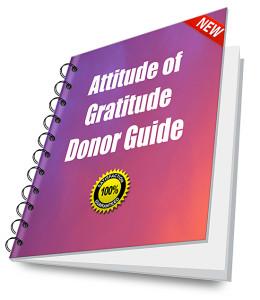
Getting in the spirit of acts of kindness
It’s been a rough decade thus far, beginning with a pandemic out there killing people. And then the hurricanes, fires, floods and earthquakes killing people. Not to mention the genocides, autocracies, global and domestic terrorists killing people. The list, unfortunately, goes inexorably on.
What can your nonprofit organization do to offer a remedy?
Kill ‘ em with kindness.
I’m talking about your supporters, of course.
In order for people to do good they have to feel good.
Seriously, philanthropy takes energy. It takes the ability to step out of one’s day-to-day grind and think about someone, or something, else. And it’s more difficult than usual for folks to find this generous space right now.
You can help.
Make this the true giving season.
I often say “If you want gifts you must give them.”
Maya Angelou says “People will forget what you said, people will forget what you did, but people will never forget how you made them feel.
Let’s talk about what you can give – as nonprofit staff and board members — to create happier supporters.
Notice a lot of folks saying “This has been a bad year?” People can use a bit of cheer. They’re tired of doom and gloom.
Remember when “random acts of kindness” was a thing? People would buy a coffee for the person behind them in line. Or they’d pay the bridge toll for the next car. Their reward was simply imagining the unexpected delight their gift would give to someone that day. Ever have it happen to you? Ever try it?
Now’s your chance!
I’d like to suggest practicing some creative planned (seemingly random, but not really) acts of kindness.
Something to bring your donors and volunteers a bit of good cheer. It can be as simple as letting them know what they did to change someone’s life for the better. Or it can be a modest, human gesture showing them how grateful you are for their support. This is something you can have fun with. And the rewards will be huge, both for you and your donors.
10 Acts of Donor Kindness For Today, and Beyond
These are just a few ideas to get you started brainstorming your own. The beauty of these acts is you can do them any time. Begin by thinking about what you might do – or are presently doing – with your own family, friends and neighbors. Then simply extend the favor to your supporters.
After all, donors are people too.
1. Home-Baked Treats
 Today I gift cookies and scones to my neighbors for birthdays, graduations, anniversaries and… just for no reason at all! I love to bake. When I worked in the trenches, one day I decided to secretly deliver plates of home-baked cookies to each of my planned giving donors. I chose a day, motored myself around the city in the early morning hours, and left the cookies on their doorsteps (Shhh…) with a little note of thanks. I got calls all afternoon with expressions of joy. Pure delight on both of our parts! Sadly (or fortunately) my list of planned gift donors grew over time, and expanded geographically, to the point where I could no longer engage in this particular activity. But I did continue to bake cookies and gift them to legacy donors whenever they made a meaningful commitment.
Today I gift cookies and scones to my neighbors for birthdays, graduations, anniversaries and… just for no reason at all! I love to bake. When I worked in the trenches, one day I decided to secretly deliver plates of home-baked cookies to each of my planned giving donors. I chose a day, motored myself around the city in the early morning hours, and left the cookies on their doorsteps (Shhh…) with a little note of thanks. I got calls all afternoon with expressions of joy. Pure delight on both of our parts! Sadly (or fortunately) my list of planned gift donors grew over time, and expanded geographically, to the point where I could no longer engage in this particular activity. But I did continue to bake cookies and gift them to legacy donors whenever they made a meaningful commitment.
You can do the same with some of your major donors.
2. Store-Bought Treats
 I recently ordered a big quart of chicken soup delivered to a fellow board member who’d contracted CovidI. You too can deliver thoughtful gifts to folks who can use a little pick-me-up. In fact, you can do this any time! When I told one of my clients, a social justice organization, about how I used to deliver baked goodies, the executive director loved the idea — but wasn’t a baker. So, guess what she did? She bought a bunch of miniature Ghirardelli chocolate bars on sale, put them in a tin with a red ribbon, added a note (“Just thinking of how you make life sweeter for the people we work with together. Sweets For the sweet! Thank you.”), and delivered them to the law firms who supported them. Feedback was instant, and helped open the door for future in-person visits.
I recently ordered a big quart of chicken soup delivered to a fellow board member who’d contracted CovidI. You too can deliver thoughtful gifts to folks who can use a little pick-me-up. In fact, you can do this any time! When I told one of my clients, a social justice organization, about how I used to deliver baked goodies, the executive director loved the idea — but wasn’t a baker. So, guess what she did? She bought a bunch of miniature Ghirardelli chocolate bars on sale, put them in a tin with a red ribbon, added a note (“Just thinking of how you make life sweeter for the people we work with together. Sweets For the sweet! Thank you.”), and delivered them to the law firms who supported them. Feedback was instant, and helped open the door for future in-person visits.
Why not do this with some of your major corporate and individual donors?
3. Home-Made Gifts
 There are plenty of personal, inexpensive gifts you can bestow to show you’re thinking of someone.
There are plenty of personal, inexpensive gifts you can bestow to show you’re thinking of someone.
- A colleague of mine, many years ago, hand-delivered jars of preserves she personally canned.
- Another colleague delivered potted plants from cuttings in her yard.
- I know someone who paints; she gave people little hand-painted postcards with subject matter tied to their interests and/or personalities. Very thoughtful.
- I know someone else who simply cut-up magazines and sent little collage cards to folks.
- You could also send a quick homemade video from your phone, or even just a photo you took.
What are your hobbies, and how might they translate to a gift? Get creative.
4. Celebration Cards
 I collect donor birthdays. I especially collect board and committee member birthdays. When folks join you, send them a form where they have an opportunity to indicate their date of birth (tell them it’s okay to leave off the year). Whenever you hear a major donor talking about a lifecycle event (e.g., birthday, anniversary, graduation, retirement), simply make a note in your database and calendar. You can even celebrate the anniversary of your donor’s first gift to you. Then, just like Starbucks, give them a little celebration treat! You can have cards printed to use precisely for this purpose (extra meaningful if you use hand-created art from clients, even if it’s paw prints!), or you can simply purchase a bunch of store greeting cards to have on hand. Whatever you send, make sure you handwrite the note and the address so it’s super personal. Don’t just sign your name to a Hallmark card and slap on a printed label. Put some thought and effort into it, please!
I collect donor birthdays. I especially collect board and committee member birthdays. When folks join you, send them a form where they have an opportunity to indicate their date of birth (tell them it’s okay to leave off the year). Whenever you hear a major donor talking about a lifecycle event (e.g., birthday, anniversary, graduation, retirement), simply make a note in your database and calendar. You can even celebrate the anniversary of your donor’s first gift to you. Then, just like Starbucks, give them a little celebration treat! You can have cards printed to use precisely for this purpose (extra meaningful if you use hand-created art from clients, even if it’s paw prints!), or you can simply purchase a bunch of store greeting cards to have on hand. Whatever you send, make sure you handwrite the note and the address so it’s super personal. Don’t just sign your name to a Hallmark card and slap on a printed label. Put some thought and effort into it, please!
Of course, you can also email or text a celebratory greeting. Personally, I prefer the mail, as it’s more likely to get opened and noticed. Plus it’s likely to hang around longer, reminding your donor of your thoughtful act.
5. Hand-Picked News
Based on what you know floats your donor’s boat, be on the lookout for articles, podcasts, television shows, films and the like that may interest them; then share!. There are two ways I used to send hand-picked news to individual donors:
- An article I spotted in a magazine or newspaper. When I started out, I’d clip it (or copy it) and send it in an envelope. Toward the end of my career in the trenches I could send an electronic link.
- An article in our organization’s newsletter. Even though I knew they received the newsletter in the mail, I liked to highlight it for them with a note letting them know I thought they might find it of particular interest.
Besides being ‘gifts,’ these actions provide the opportunity to later check in with these donors to see what reactions they had.
6. ‘How To’ Worksheets or Videos
One of my favorite gifts costs absolutely nothing. Simply share tips and ‘how-to’s’ based on your organization’s area of expertise. I call these ‘gifts of useful content.’ You’ve likely got this written up already, and are using it as handouts, website copy, blog copy, grant proposal copy or social media posts. Useful content I’ve seen shared includes:
- How to Baby Proof Your Home
- How to Keep Parents Safe at Home
- How to Save the Environment
- How to Efficiently Recycle
- How to Spot Signs of Abuse
- How to Entertain Kids on Rainy Days
- How to Be Kind to Pets
In the times of tumult we’re in, consider including actions people can take to advocate on behalf of those you serve. People generally want to help; there just waiting for you to gently show them the way.
7. Invitations to Free Events
 This has long been a smart donor cultivation strategy. No doubt you’ve hosted an open house, donor or volunteer recognition event, behind-the-scenes tour, ice cream social, expert panel, celebrity speaker or some variation on such theme. Post COVID this happened:
This has long been a smart donor cultivation strategy. No doubt you’ve hosted an open house, donor or volunteer recognition event, behind-the-scenes tour, ice cream social, expert panel, celebrity speaker or some variation on such theme. Post COVID this happened:
- Arts organizations shared free presentations of past recorded performances.
- Zoos, aquariums, museums and environmental organizations hosted behind-the-scenes virtual tours of animals, fish, art and nature.
- Social justice organizations hosted online town halls or telephone conference calls.
- Schools offered online talks by educators.
- Nonprofits of all stripes offered live Zoom Q&As.
- Some nonprofits allowed supporters to network using the break-out room function, enabling them to build community even in the midst of a pandemic.
Now we’ve learned you can not only host onsite events, but can also successfully host a virtual free event. This makes it possible to reach more broadly, and be more inclusive, than ever before.
8. Hand Written Thank You Notes
Almost no one receives handwritten mail today, so it’s super special. It shows you took time, and makes your donor feel special. So how about writing a little card as a second thank you? Get the ‘official’ acknowledgment out within 24 – 48 hours; then ask someone else in the organization to write a personal note. Maybe the letter came from the development staff, and the note comes from the executive director or board chair. Or vice-versa. Or maybe the note comes from the program director if the gift was directed to a particular area. Or maybe the note simply comes from a board member or other volunteer.
This is something concrete volunteers can do, so don’t be shy asking them. Inevitably when I’m called to consult with an organization staff tell me “board won’t do anything” and board tell me “staff never asks us to do anything.” Ask!
9. Thank You Calls
 You should actually be doing this as the norm. At least with first-time donors and donors over a particular dollar amount (that amount will depend on your organization and your bandwidth for making calls). Especially since Penelope Burk, author of “Donor-Centered Fundraising,” provides us with two decades of research telling us being thanked promptly and personally is the number one thing donors care about! If you haven’t yet grabbed this free Thank You Calls E-Book from me, please do!
You should actually be doing this as the norm. At least with first-time donors and donors over a particular dollar amount (that amount will depend on your organization and your bandwidth for making calls). Especially since Penelope Burk, author of “Donor-Centered Fundraising,” provides us with two decades of research telling us being thanked promptly and personally is the number one thing donors care about! If you haven’t yet grabbed this free Thank You Calls E-Book from me, please do!
I’d suggest thank you calls make more sense than ever today. First, many people still feel isolated and lonely, so your call may be particularly welcome. Second, more people are working from home and may be more likely to accept your call; what a wonderful opportunity to have a real conversation and maybe get to know your donor better.
10. Gift of Recognition
People need to be thanked; they love to be recognized. The difference is subtle, yet important. Recognition goes beyond ‘thank you’ and offers the gift of special notice or attention. It’s akin to the maître d’ at your local restaurant recognizing you by name when you walk in. Or the receptionist at the doctor’s office saying “Hi Claire” as I go to check in at the front desk.
There are numerous ways to bestow recognition and make people feel noticed by you. Here are a few:
- As noted above, one of the easiest is simply sending a birthday or other lifecycle recognition card.
- Follow their social media accounts so you can comment on, or share, something they post.
- Ask to join them on LinkedIn or follow them on another social media platform you both use.
- Invite them to be interviewed for an article in your newsletter, or perhaps a podcast or video you’ll share on your website.
- Simply give them direct contact information of someone in your organization to whom they can direct questions. Having ‘their own person’ recognizes their importance to you; they’re not one of the anonymous masses.
Just about any sort of recognition, public or private, makes the recipient feel accepted, appreciated and known. It bestows a warm feeling.
It’s the Thought That Counts
Think about what you might do to delight someone in the weeks ahead.
Another way to frame this is by taking a page from customer experience guru John Goodman, author of Strategic Customer Service, who talks about delivering “Psychic Pizza.” What if someone showed up right now with an unexpected gift of pizza (or something else you love, in case you’re vegan, lactose intolerant or gluten-free)? You can do the same thing for your donors by delivering them something they want – or will likely appreciate — before they ask for it.
Don’t just do what people expect.
Consider yourself as being in the happiness delivery business. Think about this, and see if you can shift your perspective. It will make not only your donors feel better, but you’ll feel better too!
And you’ll get a bigger bang for your buck when you really delight your supporters. It’s like the difference between searching for and finding that “perfect” holiday gift for someone, vs. buying just “something” from a catalogue at the last minute or giving a gift card. When you simply do the minimum you must do, it’s unlikely to give the WOW factor that makes your donor feel:
- Warm, fuzzy and filled with the joy of giving.
- Open to engaging more with you.
- Wanting to give again.
For a donor to feel “WOW! That was so nice. I never expected that. I feel I’m getting more out of this than I’m giving,” you need to come at the process of acknowledgement and stewardship from the perspective of ‘can,’ not ‘must.’ Don’t just check “touches” and “moves” of a ‘to-do’ list. Think about what you can do to bring a smile to a donor’s face or a glow to their soul.
How about some planned acts of kindness with your donors? They deserve it!
If you’re doing anything like this, please share. We can learn from each other!
Want More Creative Ways to Thank Donors?
 Grab my How To Cultivate An Attitude Of Gratitude And Keep Your Donors with 72 ‘thank you’ ideas for you to steal – plus much, much more on the process of channeling an attitude of gratitude to retain and upgrade your supporters. It’s everything I’ve learned about sustaining donor relationships over the years, all tucked it into one handy no-nonsense guide on the practice of gratitude.
Grab my How To Cultivate An Attitude Of Gratitude And Keep Your Donors with 72 ‘thank you’ ideas for you to steal – plus much, much more on the process of channeling an attitude of gratitude to retain and upgrade your supporters. It’s everything I’ve learned about sustaining donor relationships over the years, all tucked it into one handy no-nonsense guide on the practice of gratitude.
As with all Clairification products, it comes with a no-questions-asked, 30-day, 100% refund guarantee. You can’t lose.
Title Image: Three San Francisco Hearts. Doggy Days. California Street Captive. Benefit for S.F. General Hospital Foundation. Other images by me, one from Elizabeth Lemos from Pixabay, and





